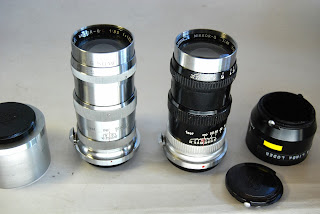 |
| Two 135mm f3.5 Nikkors: 1951 and 1959, with hoods. |
The 135mm f3.5 Nikkor-Q was to prove to be Nippon Kogaku’s most popular accessory lens for their rangefinder camera series. Rotoloni in his book on the Nikon rangefinder camera* estimates that the company produced more than 30,000 over a 13 year period from 1951 until 1964. A few prototypes went out in 1950 with full production starting in January 1951—concurrent with the earlier 135mm f4 Nikkor that dated back to 1948. For a few months production of the two optics continued side-by-side with the older optic selling mostly to the Occupation forces and the new, faster optic going to the United States where its speed gave it a sales edge over the similar Zeiss 135mm f4 Sonnar.
All 135mm f3.5 Nikkors are similar in size and features. They all focus down to five feet, all take 43mm screw-on accessories and all have a built-in tripod bushing. All of them use the same tele-Sonnar optical formula—a formula Nikon would carry over to its reflex camera lenses in 1959. But the company made a lot of other changes over the lens’ production lifetime.
 |
| Changes in minimum f-stops |
 |
| The "Tokyo" mark on the early Nikkor |
The two 135mm f3.5 Nikkors in these pictures help give an idea of some of those changes. The all-chrome-finished Nikkor is an “Occupied-Type II” lens probably dating to late spring of 1951. Serial numbers in this series begin with 253XX. The beauty ring is engraved “Nippon Kogaku Tokyo.” The diaphragm closes down to only f16 and the distance scale starts with “Inf.” Lenses meant for sale in the military exchanges were still being engraved with “Made in Occupied Japan” on their rangefinder engagement cams. Perhaps the Central Purchasing Office (CPO) still wanted that mark, or perhaps this was because NK still had a bunch of engraved cam rings in stock and could not afford to waste good parts.
 |
| The barely-visible "Made in Occupied Japan" on the 135's RF linkage ring. |
With chrome-over-brass construction throughout, this is a heavy lens, weighing 22.5 ounces (639 grams). It is heavier than either a Nikon S2 or SP camera.
The black-finished 135mm Nikkor dates from 1959. The ribbing is bolder making focusing easier. The body is mostly aluminum and now weighs only 14 ounces (398 grams), a reduction in weight of over 40 percent. The focus scale starts with the infinity mark, a change that dates back to 1956. The lens stops down to f32 and the beauty ring now says “Nippon Kogaku Japan.” Another change is the absence of the red ‘C’ past the “Nikkor-Q” engraving. This first appeared on all Nikkors in 1946 and indicated that the lens was coated. By 1959 this was no longer seen as a notable feature since virtually all optical lenses were by then routinely coated, and NK had dropped that code.
Earlier telephoto Nikkors came with heavy, screw-on lens hoods that reversed onto the lens for storage and came apart to allow use of series 7 filters. A lens cap, in turn, reversed threaded onto stored hood. In 1956, NK went to snap-on hoods that still could be reversed, along with snap-on caps that could be used on either the reversed hood or the directly on the lens.
* Robert Rotoloni. The Complete Nikon Rangefinder System. Hove Foto Books, 2007.
Copyright. Michael W. Loder 2013. All rights reserved.
No comments:
Post a Comment